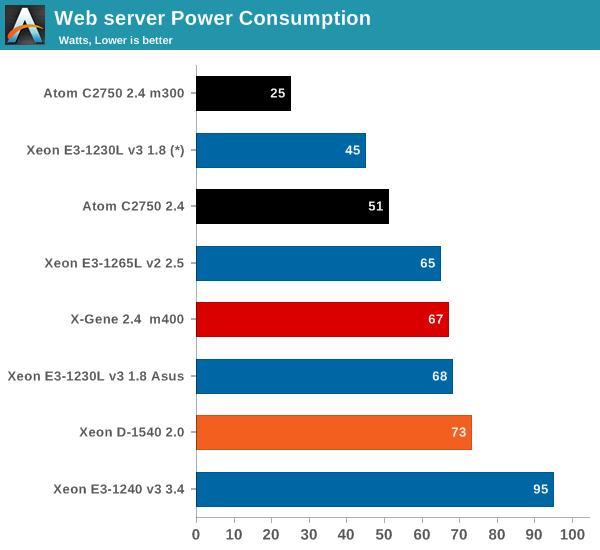The Intel Xeon D Review: Performance Per Watt Server SoC Champion?
by Johan De Gelas on June 23, 2015 8:35 AM EST- Posted in
- CPUs
- Intel
- Xeon-D
- Broadwell-DE
Web Infrastructure Power consumption
Next we tested the system under load.

(*) measured/calculated to mimic a Xeon-E3 "m300-ish" board.
Let us entangle the results by separating the power that goes to the SoC and the power that goes to the system. We did a similar though experiment in our X-Gene 1, Atom C2000 and Xeon E3 comparison.
| Power Consumption SoC Calculations | ||
| SoC | Power Delta = Power Web - Idle (W) |
Power SoC = Power Delta + Idle SoC + Chipset (W) |
| Xeon E3- 1240 v3 3.4 | 95-42 = 53 | 53+3+3 = 59 |
| Xeon E3-1230L v2 1.8 | 68-41 = 27 (45-18 = 27) |
27+3+3 = 33 |
| Xeon D-1540 | 73-31 = 42 | 42+2+0 = 44 |
| Atom C2750 2.4 | 25-11 = 13 | 13+3+0 = 16 |
Now let us combine our calculated SoC power consumption and the power measurements in the graph above. The Atom C2750 still make sense in a micro server if CPU performance is not a priority: think static webservers and caching servers. You can fit an Atom C2750 server inside a power envelop of 25W as HP has proven. Based upon our own experience, such a Xeon D system would probably require more like 55 - 60 W.
If CPU performance is somewhat important, the Xeon D is the absolute champion. A Xeon E3-1230L server with similar features (2x 10 Gb for example) will probably consume almost the same amount of power as we have witnessed on our Asus P9D board (68 W). Given a decently scaling application with enough threads or some kind of virtualization (KVM/Hyper-V/Docker), the Xeon D server will thus consume at most about 1/3 more than an Xeon E3-1230L, but deliver almost twice as much performance.










90 Comments
View All Comments
JohanAnandtech - Wednesday, June 24, 2015 - link
Hi Patrick, the base clock of our chip is 2 GHz, not 1.9 GHz as the one pre-production version that we got from Intel. I have to check the turboclocks though, but I do believe we have measured 2.6 GHz. I'll doublecheck.pjkenned - Wednesday, June 24, 2015 - link
Awesome! Our ES ones were 1.9GHz.Chrisrodinis1 - Tuesday, June 23, 2015 - link
For comparison, this server uses Xeon's. It is the HP Proliant BL460c G9 blade server: https://www.youtube.com/watch?v=0s_w8JVmvf0MrDiSante - Wednesday, June 24, 2015 - link
Why use only -O2 when compiling the benchmarks? I would imagine that in order to squeeze out every last bit of performance, all production software is compiled with all optimizations turned up to 11. I noticed that their github uses -O2 as an example - is it that TinyMemBenchmark just doesn't play nice with -O3?JohanAnandtech - Wednesday, June 24, 2015 - link
The standard makefile had no optimization whatsoever. If you want to measure latency, you do not want maximum performance but rather accuracy, so I played it safe and used -O2. I am not convinced that all production software is optimized with all optimization turned on.diediealldie - Wednesday, June 24, 2015 - link
Intel seems disARMing them... X-Gene 2 doesn't look so promising, as they'll have to fight mighty Skylake-based Xeons, not Broadwell ones.Thanks for great article again.
jfallen - Wednesday, June 24, 2015 - link
Thanks Johan for the great article. I'm a tech enthusiast, and will never buy or use one of these. But it makes great reading and I appreciate the time you take to research and write the article.Regards
Jordan
JohanAnandtech - Wednesday, June 24, 2015 - link
Happy to read this! :-)TomWomack - Wednesday, June 24, 2015 - link
This looks very much consistent with my experience; the disconcertingly high idle power (I looked at the board with a thermal camera; the hot chips were the gigabit PHY, the inductors for the power supply, and the AST2400 management chip), the surprisingly good memory performance, the fairly hot SoC (running sixteen threads of number-crunching I get a power draw of 83W at the plug) and the generally pretty good computation.I'm not entirely sure it was a better buy for my use case than a significantly cheaper 6-core Haswell E - Haswell E is not that hot, electricity not that expensive, and from my supplier the X10SDV-F board and memory were £929 whilst Scan get me an i7-5820K board, CPU and memory for £702. And four-channel DDR4 probably is usefully faster than two-channel for what I do.
I quite strongly don't believe in server mystique - the outbuilding is big enough that I run out of power before I run out of space for micro-ATX cases, and I am lucky enough to be doing calculations which are self-checking to the point that ECC is a waste of money.
JohanAnandtech - Wednesday, June 24, 2015 - link
Hi Tom, I believe we saw up to 90 Watt at the wall when running OpenFOAM (10 Gbit enabled). It is however less relevant for such a chip which is not meant to be a HPC chip as we have shown in the article. HPC really screams for an E5.